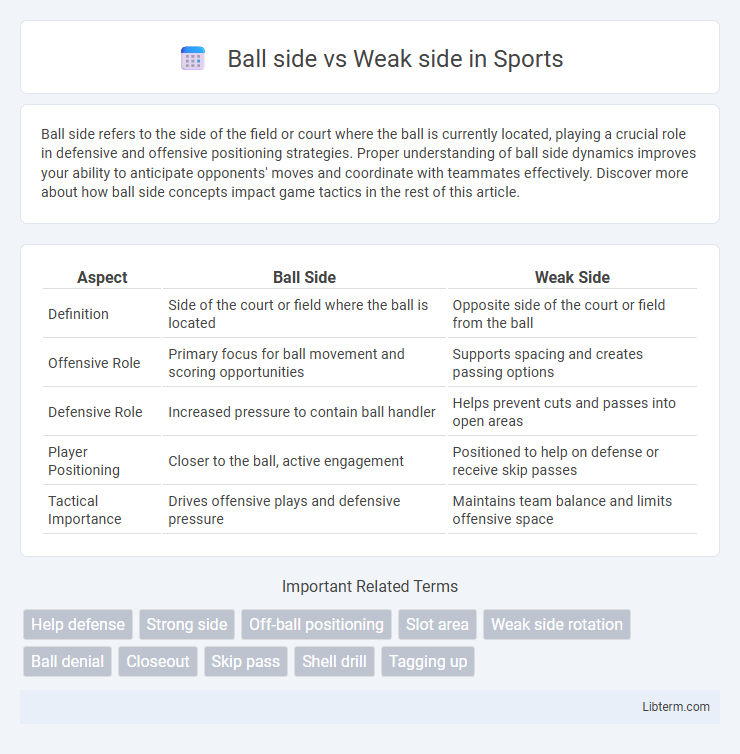Ball side refers to the side of the field or court where the ball is currently located, playing a crucial role in defensive and offensive positioning strategies. Proper understanding of ball side dynamics improves your ability to anticipate opponents' moves and coordinate with teammates effectively. Discover more about how ball side concepts impact game tactics in the rest of this article.
Table of Comparison
| Aspect | Ball Side | Weak Side |
|---|---|---|
| Definition | Side of the court or field where the ball is located | Opposite side of the court or field from the ball |
| Offensive Role | Primary focus for ball movement and scoring opportunities | Supports spacing and creates passing options |
| Defensive Role | Increased pressure to contain ball handler | Helps prevent cuts and passes into open areas |
| Player Positioning | Closer to the ball, active engagement | Positioned to help on defense or receive skip passes |
| Tactical Importance | Drives offensive plays and defensive pressure | Maintains team balance and limits offensive space |
Introduction to Ball Side and Weak Side
The ball side refers to the half of the basketball court where the ball is currently located, often characterized by increased offensive and defensive activity due to proximity to the ball handler. The weak side is the opposite half, typically featuring fewer players and serving as a strategic area for offensive spacing and potential defensive help. Understanding the distinction between ball side and weak side is crucial for effective team defense rotations and offensive positioning.
Definition of Ball Side
The ball side refers to the half of the basketball court where the ball is currently located, including the player with possession and nearby teammates or defenders. This area typically requires heightened defensive attention and strategic positioning to contest shots, passes, and drives effectively. Understanding the ball side helps teams optimize rotations and defensive coverage to reduce scoring opportunities.
Definition of Weak Side
The weak side in basketball refers to the half of the court opposite the ball side, where offensive players are positioned away from the ball handler. This area typically has less defensive pressure, creating opportunities for cuts, screens, and open shots. Defenders on the weak side must anticipate passes and help protect the basket against drives and post plays.
Importance in Team Sports
Ball side and weak side dynamics critically influence defensive and offensive strategies in team sports like basketball and soccer. The ball side, where the ball is located, demands heightened player attention and positioning to apply pressure, while the weak side requires strategic coverage to prevent easy scoring opportunities. Mastery of ball side versus weak side principles enhances team coordination, optimizing spatial control and transition phases for both defense and attack.
Offensive Strategies on the Ball Side
Offensive strategies on the ball side emphasize spacing, pick-and-roll actions, and driving lanes to exploit defensive weaknesses and create high-percentage scoring opportunities. Players on the ball side often use screen slips, quick passes, and cuts to generate open shots or facilitate penetration. Effective ball side tactics increase offensive efficiency by forcing defenders to collapse, opening up perimeter shooting and inside scoring chances.
Defensive Tactics on the Weak Side
Defensive tactics on the weak side emphasize maintaining proper positioning to prevent easy ball reversals and limit scoring opportunities from ball movement across the court. Defenders must communicate effectively, anticipate passes, and stay alert to screens or cuts originating from the weak side to prevent offensive penetration and open shots. Rotating swiftly while preserving on-ball pressure on the strong side ensures the defense remains balanced, denying the offense easy weak-side advantages.
Common Mistakes and Misunderstandings
Confusing the ball side with the weak side often leads to defensive mismatches and poor rotation in basketball. Common mistakes include neglecting proper help defense on the weak side and over-committing to the ball side, which creates open scoring opportunities. Understanding the spatial layout and maintaining awareness of both sides ensures better positioning and more effective team defense.
Drills to Improve Ball and Weak Side Awareness
Drills such as "Closeout and Recover" significantly enhance ball side awareness by training defenders to quickly contest shots and contain offensive players. Weak side awareness improves through "Help and Recover" exercises, where defenders practice providing timely help defense without overcommitting. Incorporating "Shell Drill" variations fosters simultaneous development of both ball side and weak side positioning, elevating overall defensive effectiveness.
Impact on Game Flow and Decision Making
Ball side concentration influences defensive pressure and offensive spacing, forcing quicker decisions and sharper cuts or passes. Weak side positioning creates opportunities for strategic plays by exploiting less defended zones, impacting ball movement and shot selection. Effective coordination between ball side and weak side players enhances overall game flow, optimizing scoring chances and defensive setups.
Conclusion: Mastering Both Sides for Success
Mastering both the ball side and weak side of the basketball court is essential for optimal team defense and offense. Effective ball side pressure disrupts the opponent's primary scoring opportunities, while strong weak side positioning prevents easy cuts and open shots. Balanced proficiency on both sides enhances overall court awareness, leading to greater success in game execution.
Ball side Infographic

 libterm.com
libterm.com